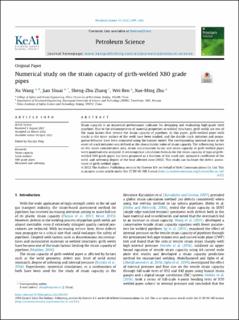| dc.contributor.author | Wang, Xu | |
| dc.contributor.author | Shuai, Jian | |
| dc.contributor.author | Zhang, Sheng-Zhu | |
| dc.contributor.author | Ren, Wei | |
| dc.contributor.author | Zhu, Xue-Ming | |
| dc.date.accessioned | 2023-02-01T14:04:15Z | |
| dc.date.available | 2023-02-01T14:04:15Z | |
| dc.date.created | 2022-10-04T08:20:29Z | |
| dc.date.issued | 2022 | |
| dc.identifier.citation | Petroleum Science. 2022, 19 (5), 2399-2412. | en_US |
| dc.identifier.issn | 1672-5107 | |
| dc.identifier.uri | https://hdl.handle.net/11250/3047780 | |
| dc.description.abstract | Strain capacity is an important performance indicator for designing and evaluating high-grade steel pipelines. Due to the inhomogeneity of material properties in welded structures, girth welds are one of the main factors that restrict the strain capacity of pipelines. In this paper, girth-welded pipes with cracks in the inner surface of the weld have been studied, and the ductile crack initiation and propagation behavior have been simulated using the Gurson model. The corresponding nominal strain at the onset of crack initiation was defined as the characteristic value of strain capacity. The influencing factors on the strain concentration area, strain concentration factor, and strain capacity of girth-welded pipes were quantitatively analyzed. A semiempirical calculation formula for the strain capacity of typical girth-welded X80 grade pipes has been proposed as a function of the crack size, mismatch coefficient of the weld, and softening degree of the heat affected zone (HAZ). This study can facilitate the defect assessment of girth-welded pipes. | en_US |
| dc.language.iso | eng | en_US |
| dc.publisher | Elsevier Inc. | en_US |
| dc.rights | Attribution-NonCommercial-NoDerivatives 4.0 Internasjonal | * |
| dc.rights.uri | http://creativecommons.org/licenses/by-nc-nd/4.0/deed.no | * |
| dc.title | Numerical study on the strain capacity of girth-welded X80 grade pipes | en_US |
| dc.title.alternative | Numerical study on the strain capacity of girth-welded X80 grade pipes | en_US |
| dc.type | Peer reviewed | en_US |
| dc.type | Journal article | en_US |
| dc.description.version | publishedVersion | en_US |
| dc.source.pagenumber | 2399-2412 | en_US |
| dc.source.volume | 19 | en_US |
| dc.source.journal | Petroleum Science | en_US |
| dc.source.issue | 5 | en_US |
| dc.identifier.doi | 10.1016/j.petsci.2022.04.009 | |
| dc.identifier.cristin | 2058118 | |
| cristin.ispublished | true | |
| cristin.fulltext | original | |
| cristin.qualitycode | 1 | |

